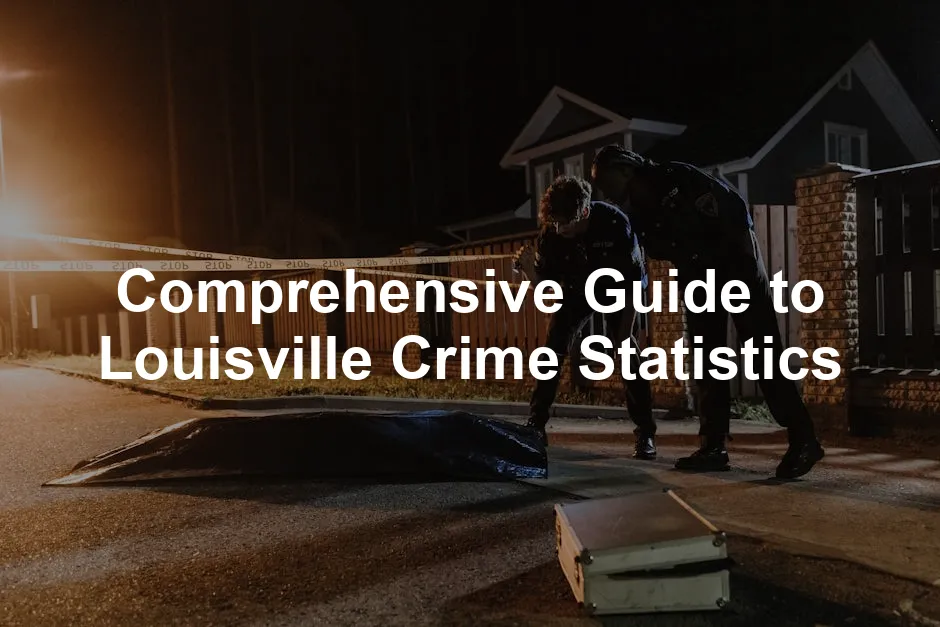Introduction
Louisville, Kentucky, is known for its vibrant culture, delicious cuisine, and, of course, the Kentucky Derby. This bustling city boasts a rich history and a diverse population, making it a unique place to live and visit. But like any major city, Louisville faces challenges, particularly concerning crime.
Understanding crime statistics is essential for several reasons. First, residents need to feel safe in their neighborhoods. For those considering a move, crime rates can influence their decision. Policymakers also rely on these statistics to develop effective strategies for public safety.
This article will cover various aspects of Louisville’s crime landscape, focusing on violent crimes and property crimes. We will also compare Louisville’s statistics to state and national averages to provide a comprehensive perspective.
Understanding Louisville’s Crime Landscape
Overview of Crime Rates
Louisville currently has an overall crime rate of 37 crimes per 1,000 residents. This figure places it among the highest crime rates in America, which can be alarming for both current residents and those contemplating a move to the area. The likelihood of becoming a victim of either violent or property crime in Louisville is approximately one in 27, significantly higher than many other communities in Kentucky.
When we break down the numbers, the violent crime rate stands at 7.51 per 1,000 residents, while property crime rates are notably higher at 29.17 per 1,000 residents. To put this into perspective, Kentucky’s violent crime rate is just 2.14 per 1,000 residents, and the property crime rate is 14.49 per 1,000 residents. These comparisons highlight the stark reality that Louisville faces a more significant challenge regarding crime than many of its counterparts in the state.
Understanding these statistics provides valuable insights into the safety of Louisville. The community’s perception of crime often influences how residents interact with one another and their environment. While many neighborhoods are safe and welcoming, the overall crime rates can lead to feelings of unease among residents.

To enhance your home security and ease your worries, consider investing in a Ring Video Doorbell. With its real-time alerts and video feed, you can keep an eye on your front door from anywhere. It’s like having a bouncer for your home, minus the tuxedo!
As we dive deeper into this topic, we will examine specific categories of crime, including violent crimes such as murder, rape, robbery, and aggravated assault. We will also explore property crimes like burglary, theft, and motor vehicle theft. By gathering and analyzing this data, we can better understand the crime landscape in Louisville and what it means for its residents. For a more detailed look at crime statistics, you can refer to Fremont Crime Statistics.
For a deeper understanding of how crime statistics play a role in community safety, check out the Fremont Crime Statistics.
Violent Crime in Louisville
– Current Violent Crime Statistics: Louisville’s violent crime rate is 7.51 per 1,000 residents. That means your chances of becoming a victim are roughly 1 in 133. Not exactly a winning lottery ticket!
– Types of Violent Crimes: The categories of violent crimes include murder, rape, robbery, and aggravated assault. Here’s a quick breakdown:
- Murder: Much higher than the national average.
- Rape: Notably concerning, with rates fluctuating.
- Robbery: A significant worry for many residents.
- Aggravated Assault: The most common violent crime in the city.
– Comparative Analysis: Louisville’s violent crime rate far surpasses Kentucky’s average of 2.14 per 1,000 residents and the national average. When you put it in perspective, Louisville’s stats can look like a horror movie compared to the calm drama of most other towns.

Want to ensure your personal safety? Consider a SABRE Personal Alarm. It’s small, but it packs a punch! This handy device can emit a loud sound to deter potential threats and alert others to your location. It’s like having a personal bodyguard in your pocket!
Property Crime in Louisville
– Current Property Crime Statistics: The property crime rate is 29.17 per 1,000 residents, which translates to a 1 in 34 chance of being a victim. That’s like rolling a dice and landing on the wrong number!
– Types of Property Crimes: Property crimes mainly include burglary, theft, motor vehicle theft, and arson. Here’s the scoop:
- Burglary: A frequent issue that keeps homeowners on their toes.
- Theft: Ranging from petty to grand, it’s a common concern.
- Motor Vehicle Theft: Louisville has one of the highest rates in the nation.
- Arson: A firestarter’s playground, unfortunately.
– Comparative Analysis: Louisville’s property crime rate stands in stark contrast to Kentucky’s average of 14.49 per 1,000 residents, as well as the national average. When it comes to property crime, Louisville is certainly in a league of its own, and not in a good way!

For those looking to secure their belongings, consider a AmazonBasics Security Safe. It’s a great option for keeping your valuables secure and out of reach from unwanted guests. Because let’s be honest, nobody wants to play hide and seek with their important documents!
Understanding these statistics helps residents and potential movers gauge safety in the Derby City. It’s clear that knowledge is power, especially when it comes to navigating the streets of Louisville.

Detailed Crime Insights
Trends Over the Years
Louisville’s crime statistics tell a story of fluctuating rates over the years. Historical data reveals that crime rates have experienced both increases and decreases, often influenced by societal changes and law enforcement strategies. For instance, between 2003 and 2022, Louisville saw a peak in violent crime rates, with a staggering 1,346.4 incidents per 100,000 residents in 2003. However, as the years progressed, there were attempts to curb these numbers through community programs and increased police presence.
In recent years, some reports indicate a slight decrease in crime rates, with a 5% drop noted in 2023. This shift suggests that efforts to enhance community safety are having an impact. However, incidents such as the alarming rise in shootings in 2024 remind us that challenges remain. Law enforcement has adapted by implementing new strategies, such as increased patrols in high-crime neighborhoods and community engagement initiatives. These changes aim to build trust and cooperation between residents and police, which is vital for long-term crime reduction.

Neighborhood Crime Statistics
Louisville’s neighborhoods present a mixed bag of safety levels. Among the safest neighborhoods are Todds Point and Fisherville, boasting lower crime rates than the city average. Residents here enjoy a sense of community and security, making them attractive for families and newcomers. In contrast, some areas, such as Portland and Chickasaw, struggle with higher crime rates, particularly violent crimes like shootings and robberies.
In Portland, for instance, recent statistics have shown a significant uptick in shootings, leading to heightened community concern. The prevalence of gun violence in these neighborhoods starkly contrasts with the tranquil lives of those in safer areas. Understanding the crime landscape is crucial for potential movers and current residents alike, as it helps them make informed decisions about their safety and community engagement.

Crime Mapping and Analysis
To navigate the crime landscape effectively, residents can utilize crime mapping tools. These visual aids provide a comprehensive overview of crime incidents across Louisville, allowing individuals to see patterns and trends. For instance, crime maps color-code neighborhoods based on the frequency of reported incidents, helping residents identify safer areas.
By using these tools, residents can make informed choices about their daily activities and understand which neighborhoods to approach with caution. Additionally, community associations often share crime map data during meetings, fostering discussions about safety measures and collective action. Awareness of crime patterns can empower citizens to advocate for safer environments and engage in local safety initiatives.
Overall, understanding Louisville’s crime statistics requires examining historical trends, neighborhood dynamics, and utilizing available resources. With a commitment to community safety and proactive engagement, residents can contribute to a more secure Louisville for all.

Factors Influencing Crime Rates
Understanding the factors influencing crime rates in Louisville is essential for grasping the complexities of its crime landscape. Various elements come into play, including socioeconomic conditions, law enforcement initiatives, and community perceptions of safety. Let’s break these down!
Socioeconomic Factors
Louisville’s crime rates are tied closely to socioeconomic status. Poverty levels in the city contribute significantly to crime. When families struggle to make ends meet, frustration can boil over into criminal behavior. It’s often said that crime loves company, and unfortunately, poverty can be that unwanted friend.
Household instability also plays a role. Families facing challenges like divorce, job loss, or housing insecurity create an environment where crime can thrive. Access to resources like education and healthcare is vital. When these are lacking, communities may face higher crime rates. Imagine trying to compete in a race without shoes—hard, right? That’s what it’s like for many in under-resourced areas of Louisville.

For those looking to build strong community ties and improve local safety, consider reading “Community: The Structure of Belonging” by Peter Block. This insightful book explores how to foster connections and create safer neighborhoods through community engagement. It’s like having a roadmap to building a better neighborhood!
Law Enforcement and Community Programs
The presence of law enforcement can deter crime, but it’s not just about having more police officers. Community programs also play a crucial role. Initiatives like neighborhood watch groups or youth outreach programs help foster trust and collaboration between residents and police.
Take, for instance, the success stories from programs focused on youth engagement. These initiatives have shown to reduce crime rates by providing alternatives and positive role models for young people. When kids have things to do after school, they’re less likely to find trouble. It’s like giving a bored cat a ball of yarn—suddenly, it has a purpose!
Moreover, police responsiveness matters. While some residents feel safe with visible patrols, others may perceive police presence as intimidating. Survey data indicates that community sentiment varies widely. Some see police as protectors, while others view them with skepticism. Creating a balance is key.

Public Perception and Safety Concerns
Public perception of safety significantly influences crime rates. Surveys indicate that a majority of Louisville residents feel somewhat safe, yet many express concerns about crime. This mixed sentiment can lead to underreporting of crimes. If people believe that no one will help, they might not bother to report incidents.
When residents perceive their neighborhoods as unsafe, it can lead to a downward spiral. Fear can stifle community engagement and deter individuals from participating in local initiatives. The irony is palpable; the very fear of crime can create a less safe environment.
Moreover, community discussions around crime, often amplified by social media, can skew perceptions. A single incident can snowball into a larger narrative, framing an entire neighborhood as dangerous. This highlights the importance of addressing misconceptions and fostering open dialogue about safety.
In summary, crime rates in Louisville are influenced by a tapestry of socioeconomic factors, law enforcement efforts, and public perception. By understanding these dynamics, residents and policymakers can work together to create a safer environment for all. With continued effort, Louisville can transform its challenges into opportunities for growth and community strength.

Comparison with Other Cities
State-Level Comparison
When it comes to crime rates, Louisville often steals the spotlight in Kentucky—for all the wrong reasons. With an overall crime rate of 37 per 1,000 residents, it’s clear that Louisville is not just another city in the Bluegrass State. It stands out as an outlier compared to its fellow cities like Lexington and Bowling Green. For instance, Lexington, with a crime rate of around 20 per 1,000 residents, paints a much calmer picture. Bowling Green isn’t far behind, boasting even lower figures.
Now, let’s not sugarcoat it: Louisville’s violent crime rate sits at 7.51 per 1,000 residents. In contrast, Lexington’s is about 2.14, which raises eyebrows. This stark difference indicates that Louisville’s crime issues are not merely a reflection of broader trends in Kentucky but rather a significant concern that requires urgent attention.
Why does this matter? For residents and prospective movers, these statistics are more than just numbers—they’re an insight into safety and community well-being. Policymakers in Louisville must take note of these comparisons to devise effective crime reduction strategies. After all, if you live in a city where the crime rate is significantly higher than your neighbors, it’s time to take a closer look at what’s going wrong.

National Comparison
Zooming out to a national level, Louisville’s crime statistics are even more eye-opening. The city’s crime rate is approximately 55% higher than the national average. When compared to the national violent crime rate, which stands at about 4.0 per 1,000 residents, Louisville’s 7.51 per 1,000 looks even worse. This places it among the top dangerous cities in the United States, raising alarms for both residents and local authorities.
What do these numbers mean for the average Louisville resident? Well, the chances of becoming a victim of crime in Louisville are approximately 1 in 27, which is quite higher than the national average of 1 in 36. This creates a palpable sense of unease within the community. Residents may feel compelled to adapt their daily routines, whether that means avoiding certain areas after dark or investing in home security systems.

Speaking of home security, a solid choice is the Blink Indoor Home Security Camera. It provides 24/7 monitoring and is a great way to keep an eye on your property from anywhere. It’s like having a security guard who doesn’t need coffee breaks!
For policymakers, these comparisons underscore the need for robust community programs and law enforcement initiatives. The implications are clear: Louisville must tackle its crime rates head-on, taking cues from cities that have successfully reduced crime through innovative strategies. A proactive approach is essential for fostering a safer environment for all residents.

FAQs
What is the current crime rate in Louisville?
As of 2023, Louisville has an overall crime rate of 37 per 1,000 residents. This alarming figure places it among the highest crime rates in the United States, making it crucial for residents to be aware of their surroundings.
How does Louisville’s crime rate compare to other cities in Kentucky?
Louisville’s crime rate is significantly higher than other major cities in Kentucky. For instance, Lexington’s crime rate is around 20 per 1,000 residents, while Bowling Green is even lower. This stark contrast highlights Louisville’s unique crime challenges within the state.
What are the safest neighborhoods in Louisville?
Some of the safest neighborhoods in Louisville include Todds Point, Fisherville, and Lake Forest. These areas have lower crime rates and offer a sense of community and security for their residents.
What resources are available for crime reporting and community safety?
Residents can report crimes to the Louisville Metro Police Department at (502) 574-7111. Additionally, community safety resources include neighborhood watch programs and local community centers that promote safety initiatives.
How often are crime statistics updated?
Crime statistics in Louisville are typically updated annually. The most current data reflects the previous year’s information, as reported by local law enforcement agencies. Staying informed about these updates is vital for understanding crime trends in the city.
Please let us know what you think about our content by leaving a comment down below!
Thank you for reading till here 🙂
All images from Pexels




